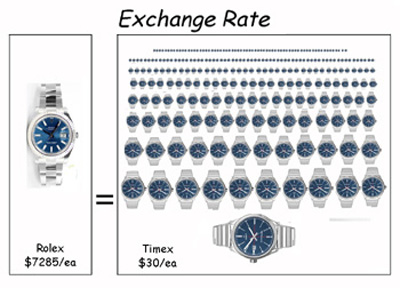Timex or Rolex?
- Aria Fox
- April 8, 2023
Timex, hands down. Please understand, I don’t have a grudge against Rolex watches because I can’t afford one–although, at an average price of $8000, it would pinch a little. I like the way the Timex looks–modest, practical, tasteful. It doesn’t shout, “Look at me! I’M RICH!” Also, a Timex watch is not a fussy gadget. It’s a workhorse.
Lighted dial
Timex watches have lighted dials. Rolex watches do not. Eight grand and no lighted dial? Come on. True, some have “luminescent” dials, but Rolex wearers say that the glow lasts a couple of hours at best. The Rolex owner who wakes in the dark wanting to know the time has to grope for a bedside lamp. Timex wearers just push the Indiglo button. Voila. The dial lights up clear as day.
Keeps on ticking…
Timex watches run for years on a single battery. Rolex watches, the manufacturer boasts, are self-winding. But only if you wear them regularly. If leave your watch on the dresser for more than 48 hours, it’s likely to go dead.
What’s more, the manufacturer warns, “The lubricants in the mechanism may harden, causing friction within the movement.
Eventually, the friction may damage the movement.”
For an $8000 miracle of technology, this watch sounds pretty touchy.
Mugger appeal
No one’s going to mug you for a lousy Timex. On the other hand, the Rolex is a mugger magnet. Using the good sense that made them rich, Rolex owners often leave their watches in a sock drawer when they go to Detroit on business or take the family on vacation to Mexico City. While they’re gone, the Rolex sits in the dark drawer grumbling about neglect, stiffening of lubricants, etc., and plotting revenge. Who needs that?
Water resistance
The Timex is water resistant to a depth of 99 feet. Rolex watches are good to 330 feet. Yay for Rolex. Personally, I can’t think of an occasion in this life when I or anybody I know would be submerging a watch under more than a couple of feet of water.
The manufacturer says, “This waterproofing means that not only can you take a shower while wearing your watch, but you can also swim with it. Deep water diving, however, should be avoided while wearing most Rolex watches. For such demanding aquatic situations, Rolex has created the Submariner and the Sea-Dweller models.”
Say again? Didn’t I just read that the Rolex is waterproof to 330 feet? What exactly qualifies as “deep water diving”?
The manufacturer goes on: “If you own or choose to purchase a non-diver Rolex watch, treat it as no more than moderately water resistant due to the age and custom craftsmanship involved in its production. To be safe, we suggest the watch not be worn while swimming or even showering, although a slight amount of water contact–such as may occur while washing your hands.” (Italics mine.)
Excuse me while I roll on the floor laughing.
Cleaning the watch
My Timex must take life as it comes. Not a Rolex. The manufacturer writes, “Like any other work of intricate artistry and technology, a Rolex requires occasional cleaning and upkeep. There are many places on the watch where dirt, body oils, and other greasy particles accumulate–such as between the links on the bracelet, the area joining the case and the bezel, and around the Cyclops lens. With repeated use and the gathering of dirt particles, your watch will require a thorough cleaning as described here.” Hoo boy. I’ll spare you the detailed instructions. Let me just say that I once had an MG TD that required less maintenance. And it was a hell of a lot more fun.
Wristband
In case you have nothing better to do with your evenings, the Rolex people suggest polishing and cleaning the wristband of the watch. “The bracelet of your Rolex needs special care, as it is prone to scratches. This is especially true of the Oyster bracelet which features polished center links.”
In other words, the surface of this fussy gadget goes to hell easily.
Are you ready for this? “Make sure you use the cloth only on the polished surface of your bracelet. If you use it on the non-polished surface, it will damage the brushed finish. One way to avoid polishing the brushed surfaces is to use a Q-Tip, wrapping the polishing cloth around its head and carefully restricting the buffing movement to the targeted areas. Avoid using circular or cross strokes while polishing. Instead, try to follow the flow of the metal. In other words, go with the grain of the surface (not against the grain). “
Pass me the Q-Tip, please. I need to clean my ears. What did they say this wristband was made of? Pewter?
There’s more. “Finally, avoid polishing surfaces that have no scratches. You will end up removing a fine layer of metal from the surface by way of polishing because the surface has not suffered any indentation in the form of a scratch. In these areas, less is more.” Except that you’ll need a jeweler’s loupe and a microscope.
Violins, please…
The manufacturer ends on this inspiring note: “By treating your Rolex with the respect and care that such a great treasure deserves, you will continue to enjoy a machine that looks and functions as a brand new watch for decades to come.”
Or, you could just buy a twenty-five dollar Timex, never wind or clean it, and get a new battery every two or three years. If the watch falls down a manhole or is stolen from a washroom, no tragedy. Buy another.
The next time someone brags about his Rolex, ask to see the lighted dial.

